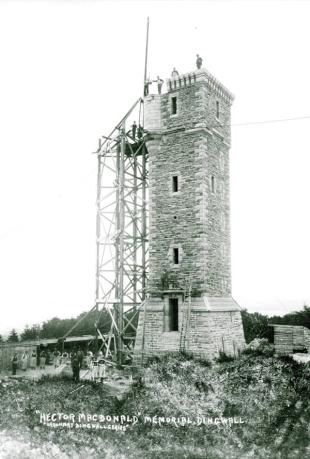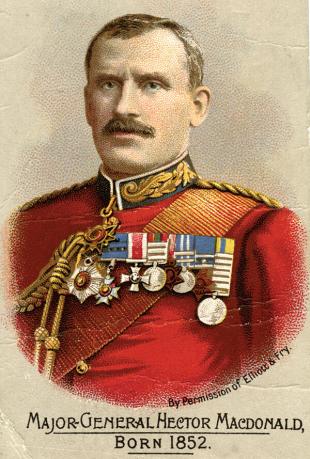Look up the hill towards that imposing tower rising above the rook-filled trees.
That hill, long ago called Knockdowmore or the Big Brown Hill and later the Greenhill, may once have been a lookout point for the security of the Thing meetings held by the 11th-Century Norse. In recent centuries the old Road Goyal formed a drove road for cattle coming to market along the ridge from the west. The auction mart on the Maryburgh Road has a detailed exhibition on the developments and history of the drove roads.


Sir Hector MacDonald
You can walk or drive up the road to see that 30- metre 1906 building close up. In the centre of the modern burial ground presented to the town by its landowner Provost Henry Mitchell it is the National Memorial to Sir Hector MacDonald celebrating the life of this Victorian national hero of the North-West Frontier— where he made the leap from ordinary soldier to officer—and Omdurman and the Boer Wars where he showed his bravery and organising ability. He was promoted to Major General and was an ADC to Queen Victoria. The Museum in the Town House holds many memories of him.
Around it are the cannon presented to the burgh and—up to a century ago—occasionally fired by Hugh Urquhart, a retired Master Gunner in the Royal Artillery, shoemaker, tobacconist and family historian of the Victorian period in the town.
The monument found a new use during WW2 from which to spot any hostile aeroplane approaching the Cromarty Firth naval base.
Cabbage Town?
For centuries the area where you are standing comprised narrow fields stretching to the hill from the backs of High Street houses for the crops or animals of each family home. The names ‘Kempfield’ and ‘Mansefield’ reflect these strips. An old (and rather dismissive) by-name for Dingwall was Bailechaul, or Cabbage town, perhaps from the sight of the green crops the people grew on such strips on the ‘urlar’ or floor of the valley, but Dingwall was the market centre supplying families for miles around.
Further Reading
There have been many books on Sir Hector including two published by the Dingwall Museum Trust: DMT5 - The Ranker; Major General Sir Hector Macdonald and DMT7 - Kenneth I E Macleod: A Victim of Fate.
Trevor Royle: Fighting Mac, the Downfall of Major-General Sir Hector MacDonald (2003, 2nd edition of his Death Before Dishonour)
Ailean Friseal: Eachan nan Cath (1979)
John Montgomery: Toll for the Brave, the tragedy of Hector Macdonald (1963)
Thomas F G Coates: Hector Macdonald, the Private who Became a General (1900)
David Campbell: Major General Hector A Macdonald CB DSO LLD (n.d. c1900)
Panel sponsored by ARK Estates (Scotland) Ltd.
Do you know something we don't?
Please contact us if you spot an error here or on the panel, or if you have a suggestion for improving the information using »»» this form.

Once you have enjoyed your walk and learning more about Dingwall, you can donate between £1 and £20 by text towards the maintenance and development of the Heritage Trail.
Text DINGWALL to 70450 to give £3.
To donate any other value, add the digit/s: e.g. DINGWALL5 gives £5, DINGWALL12, £12. We, along with over 5500 charities across the UK, trust DONR to collect donations securely.
